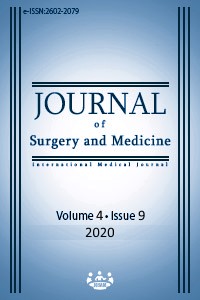Do early neutrophil to eosinophil ratio and the levels of neutrophil and white blood cells predict intra-hospital mortality in patients with spontaneous intracerebral hemorrhages?
Keywords:
White blood cell, Spontaneous intracerebral hemorrhage, Neutrophil, Inflammatory parameters, Red blood cell distribution width, Neutrophil/lymphocyte ratio, Neutrophil/eosinophil ratioAbstract
Aim: In recent years, inflammatory markers such as red blood cell distribution width (RDW), neutrophil to lymphocyte ratio (NLR), and C-reactive protein to albumin ratio (CAR) have been investigated in spontaneous intracerebral hemorrhage (ICH). However, they were not analyzed together in ICH. In the present study, we examined whether neutrophil, neutrophil to eosinophil ratio (NER), and white blood cell (WBC) levels along with the above-mentioned markers predict the intrahospital mortality in patients diagnosed with spontaneous ICH at admission. Methods: We conducted this retrospective cohort study by examining spontaneous ICH patients hospitalized in our clinic between April 2015 and March 2019. We divided patients into two groups, as survivors and non-survivors. The receiver operating characteristics (ROC) curve analysis test was used to evaluate the predictive value of laboratory variables for mortality and to calculate cut-off values. Results: A total of 130 patients, 82 survivors and 48 non-survivors, were included in the study. The patients who were non-survivors at the hospital had significantly higher median hemorrhage volume, WBC, and neutrophil levels compared to those of survivors (P<0.001, P=0.001 and P=0.003, respectively). There was no significant difference between the two groups in terms of median CAR, NLR, NER, and RDW-SD values (P=0.216, P=0.237, P=0.229, and P=0.215, respectively). The area under the ROC curve was 0.676 (95% CI, 0.57-0.78) for WBC and 0.659 (95% CI, 0.56-0.76) for neutrophil. Conclusion: Our results showed that the elevated neutrophil and WBC levels at the acute phase of spontaneous ICH predict the intrahospital mortality of the patients. Further studies are required for the predictive value of NER.
Downloads
References
Sarti C, Rastenyte D, Cepaitis Z, Tuomilehto J. International trends in mortality from stroke, 1968 to 1994. Stroke. 2000;31(7):1588-601. doi: 10.1161/01.str.31.7.1588
Feigin VL, Lawes CM, Bennett DA, Anderson CS. Stroke epidemiology: a review of population-based studies of incidence, prevalence, and case-fatality in the late 20th century. Lancet Neurol. 2003;2(1):43-53. doi: 10.1016/s1474-4422(03)00266-7
Hemphill JC, Greenberg SM, Anderson CS, et al. Guidelines for the management of spontaneous intracerebral hemorrhage: a guideline for healthcare professionals from the American Heart Association/ American Stroke Association. Stroke. 2015;46:2032-60. doi: 10.1161/STR.0000000000000069
Schmidt FA, Liotta EM, Prabhakaran S, Naidech AM, Maas MB. Assessment and comparison of the max-ICH score and ICH score by external validation. Neurology. 2018;91(10):e939-e946. doi: 10.1212/WNL.0000000000006117.
Lattanzi S, Silvestrini M, Provinciali L. Elevated blood pressure in the acute phase of stroke and the role of Angiotensin receptor blockers. Int J Hypertens. 2013;2013:941783. doi: 10.1155/2013/941783.
Lattanzi S, Cagnetti C, Rinaldi C, Angelocola S, Provinciali L, Silvestrini M. Neutrophil-to-lymphocyte ratio improves outcome prediction of acute intracerebral hemorrhage. J Neurol Sci. 2018;387:98-102. doi: 10.1016/j.jns.2018.01.038.
Zhang J, Cai L, Song Y, et al. Prognostic role of neutrophil lymphocyte ratio in patients with spontaneous intracerebral hemorrhage. Oncotarget. 2017;8(44):77752-60. doi: 10.18632/oncotarget.20776.
Di Napoli M, Parry-Jones AR, Smith CJ, et al. C-reactive protein predicts hematoma growth in intracerebral hemorrhage. Stroke. 2014;45(1):59-65. doi: 10.1161/STROKEAHA.113.001721.
Bender M, Haferkorn K, Friedrich M, Uhl E, Stein M. Impact of Early C-Reactive Protein/Albumin Ratio on Intra-Hospital Mortality Among Patients with Spontaneous Intracerebral Hemorrhage. J Clin Med. 2020 Apr 24;9(4). pii: E1236. doi: 10.3390/jcm9041236.
Altintas O, Duruyen H, Baran G, et al. The Relationship of Hematoma Growth to Red Blood Cell Distribution Width in Patients with Hypertensive Intracerebral Hemorrhage. Turk Neurosurg. 2017;27(3):368-73. doi: 10.5137/1019-5149.JTN.16136-15.1.
Forthofer RN, Lee ES, Hernandez M. Biostatistics: A Guide to Design, Analysis and Discovery. 2nd Ed. United States of America: Elsevier Academic Press; 2007. doi: 10.1016/C2009-0-03861-6.
Leira R, Dávalos A, Silva Y, et al; Stroke Project, Cerebrovascular Diseases Group of the Spanish Neurological Society. Early neurologic deterioration in intracerebral hemorrhage: predictors and associated factors. Neurology. 2004;63(3):461-7. doi: 10.1212/01.wnl.0000133204.81153.ac
Lattanzi S, Brigo F, Trinka E, Cagnetti C, Di Napoli M, Silvestrini M. Neutrophil-to-Lymphocyte Ratio in Acute Cerebral Hemorrhage: a System Review. Transl Stroke Res. 2019;10(2):137-45. doi: 10.1007/s12975-018-0649-4.
Wang J, Doré S. Inflammation after intracerebral hemorrhage. J Cereb Blood Flow Metab. 2007;27(5):894-908. doi: 10.1038/sj.jcbfm.9600403.
Aronowski J, Hall CE. New horizons for primary intracerebral hemorrhage treatment: experience from preclinical studies. Neurol Res. 2005;27(3):268-79. doi: 10.1179/016164105X25225
Zhou Y, Wang Y, Wang J, Anne Stetler R, Yang QW. Inflammation in intracerebral hemorrhage: from mechanisms to clinical translation. Prog Neurobiol. 2014;115:25-44. doi: 10.1016/j.pneurobio.2013.11.003.
Chen S, Yang Q, Chen G, Zhang JH. An update on inflammation in the acute phase of intracerebral hemorrhage. Transl Stroke Res. 2015;6(1):4-8. doi: 10.1007/s12975-014-0384-4.
Moxon-Emre I, Schlichter LC. Neutrophil depletion is lower-brain barrier breakdown, axon injury, and inflammation after intracerebral hemorrhage. J Neuropathol Exp Neurol. 2011;70(3):218-35. doi: 10.1097/NEN.0b013e31820d94a5.
Wirth MD, Sevoyan M, Hofseth L, Shivappa N, Hurley TG, Hébert JR. The Dietary Inflammatory Index is associated with elevated white blood cell counts in the National Health and Nutrition Examination Survey. Brain Behav Immun. 2018;69:296-303. doi: 10.1016/j.bbi.2017.12.003.
Sun W, Peacock A, Becker J, Phillips-Bute B, Laskowitz DT, James ML. Correlation of leukocytosis with early neurological deterioration following supratentorial intracerebral hemorrhage. J Clin Neurosci. 2012;19(8):1096-100. doi: 10.1016/j.jocn.2011.11.020.
Downloads
- 255 561
Published
Issue
Section
How to Cite
License
Copyright (c) 2020 Ersin Özeren, Muzaffer Güneş
This work is licensed under a Creative Commons Attribution-NonCommercial-NoDerivatives 4.0 International License.
















